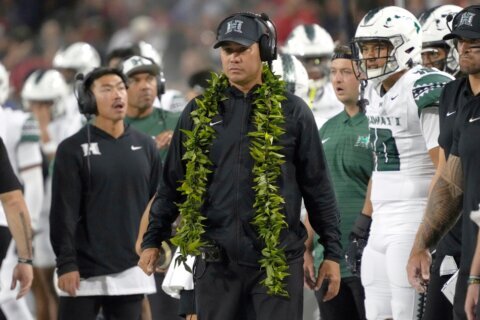On a Saturday minus any Top 25 matchups, perhaps the most intriguing game took place at Penn State, where the No. 7 Nittany Lions were upset by Illinois 20-18 in nine overtimes.
And unlike the seven-overtime affair between LSU and Texas A&M a few years ago that finished 74-72, the new-look OT turned into a version of penalty kicks or a hockey shootout, with teams attempting alternating two-point conversions. Unfortunately, it also looked like a pair of punch-drunk fighters swinging at the air in the later rounds.
Area schools have had a mixed bag in overtime lately: Maryland beat Minnesota last year, thanks to a missed extra point before falling to Rutgers because of a missed field goal. Virginia Tech topped North Carolina in a six-overtime affair in 2019. Virginia dropped a pair of OTs to end the 2018 regular season. And Navy lost in overtime to SMU that fall, thanks to a Mustangs two-point conversion.
The two-point conversion was added in 1958, in theory to eliminate ties — coaches scoring late touchdowns could go for the win. Before Division I-A (now FBS) added overtime in 1996, schools famously went for two (No. 1 Nebraska in the 1983 Orange Bowl lost a National Title on an incomplete pass) or did not (No. 1 Notre Dame in 1966 kept its title hopes alive by not playing to win against No. 2 Michigan State).
Those that did and missed were lionized, while those that played it safe earned scorn. Ties kept championships away from unbeaten teams like Ohio State in 1973, USC in 1979 and SMU in 1982. Auburn going for a tie in the 1988 Sugar Bowl caused an entire Syracuse fan base to detest Tigers coach Pat Dye for some time (for the record, the late Dye did have four ties in his last six years with the school).
To be honest, I never minded ties in college football, and I had to sit through back-to-back ties at the Carrier Dome as a junior. And, although the NFL format is not perfect (give us sudden victory or the 15-minute period back), I think it’s a fair compromise. Continuing the game is better than turning it into a drills competition.
And if you can’t decide something in 70 minutes, perhaps neither team deserved to win in the first place. Or, as we saw at Beaver Stadium after sixty minutes and eight overtimes, perhaps both teams deserved to lose twice. All I know is that on a weekend when one local almost pulled off a major upset and another punched its postseason ticket, I’m thinking and writing overtime about overtime.
Navy (1-6, 1-4 AAC) took an early lead against No. 2 Cincinnati and had a chance to be up three points at the half, armed with a 1st & 10 from the Bearcats’ 25 with under a minute to play in the second quarter. Unfortunately a loss of three and a sack that lost six had the Mids lining up for a 51-yard field goal, which was blocked and returned to the Navy 34, and Cincinnati kicked a 52-yard field goal to head into the locker room up three and steal the momentum in what would be a 27-20 Navy loss. It was an aggravating defeat because they had a window of opportunity for an upset, but lost by seven to an unbeaten team for the second time in three weeks.
Midshipmen Medals: Tai Lavatai threw for 116 yards while running for a pair of touchdowns. Fullback Isaac Ruoss led the team with 80 yards rushing. Jamal Glenn notched 11 tackles, intercepted a pass in the red zone and recovered an onside-kick in the fourth quarter. The defense held Cincinnati to a season-low 271 yards.
Midshipmen Miscues: The offense had issues in the second half, converting just two of 10 third downs. The defense allowed a pair of big-play touchdowns (a 32-yard pass and a 43-yard run). And special teams not only had the field goal blocked, but gave the Bearcats an average starting field position at the Cincy 44.
Next: Friday at 7:30 p.m. on the road against 3-4 Tulsa.
Virginia Tech (3-4, 1-2 ACC) looked as though it would beat Syracuse with a little help from its opponent: SU missed an 18-yard field goal at the end of the first half and the Hokies returned a blocked extra point back for two points. But they would allow 28 second half points, including 21 in a fourth quarter that saw the visitors score two touchdowns in the final three minutes of regulation as Tech slipped under .500 with a 41-36 loss to the Orange.
Hokie Highlights: Malachi Thomas rushed for 151 yards and three touchdowns. Nasir Peoples and Tae Daley led the defense with 11 tackles apiece. Punter Peter Moore averaged 49.5 yards per kick while Chamarri Conner blocked an extra point attempt that was returned for two points by Darian Strong.
Hokie Humblings: Braxton Burmeister completed just 50% of his passes (he’s now 36-for-82 in October) and was sacked three times. The defense allowed 314 yards rushing and gave up scoring runs of 21 and 28 yards while surrendering a 45-yard TD pass that would win it for the Orange. SU converted only 7-16 third downs but went 4-4 on fourth down, in effect making the Orange 11-16 at keeping the ball.
Next: Saturday at noon against 3-4 Georgia Tech.
Maryland (4-3, 1-3 Big Ten) trailed Minnesota 17-10 at the half thanks to a pair of missed field goals (one blocked). But the Golden Gophers would march 75 yards on 11 plays for a touchdown to start the third quarter and would score on their next two possessions as the Terps tumbled 34-16. The good news is they still play Rutgers & Indiana (combined 0-8 in the Big Ten). The bad news is Penn State, Michigan State and Michigan (19-2 overall this fall) are on the schedule as well.
Terrapin Triumphs: Freshman Marcus Fleming made the most of his opportunity (Dontay Demus Jr. & Jeshaun Jones are both out with injuries) by making five catches for 62 yards and his first career touchdown. Nick Cross paced the defense with 13 tackles. The Terps got points on all three of their trips to the red zone. The punting duo of Colton Spangler and Anthony Pecorella averaged 51 yards per kick.
Terrapin Troubles: The defense allowed 326 yards rushing (5.8 per carry) to a backfield decimated by injuries. There were multiple drops in the passing game. And penalties proved to be a problem that won’t go away, with six for 65 yards in the first half and eight for 79 for the day.
Next: Saturday at noon against 2-5 Indiana.
Virginia (6-2, 4-2 ACC) reverted to the “Cardiac Cavaliers” charm that made them so much fun in last-second wins over Miami and Louisville when they hosted Georgia Tech. From falling behind 13-0 by letting the Yellow Jackets reach the end zone on their first two possessions to allowing a pair of fourth quarter touchdowns and two successful onside kicks, the 48-40 victory secured bowl eligibility and kept them in contention for the Coastal Division title.
Cavalier Congrats: Brennan Armstrong threw for 396 yards and four touchdowns while running for 99 more and two scores. The tailback tandem held its own with 141 yards on 18 tries and the offense converted 7-11 third downs. Joey Blount notched eight tackles and recorded an interception that led to the touchdown that gave them the lead for good. Jacob Finn averaged 48.5 yards per punt.
Cavalier Concerns: The defense allowed 570 yards of total offense and surrendered scoring plays of 36, 37 and 71 yards. I can understand allowing one onside kick, but two? And can we get the defending Coastal Division champs off the ACC Network.
Next: Saturday at 10:30 p.m. on the road at 6-2 BYU.







